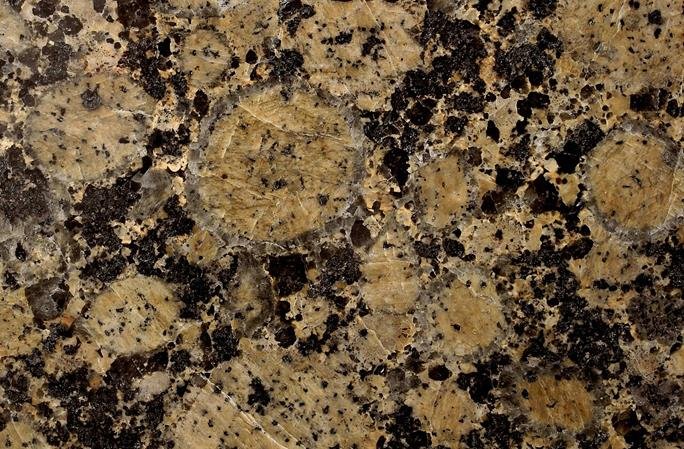Rapakivi texture forms when sodium plagioclase overgrows on or rims large, oval to ellipsoidal potassium feldspar phenocrysts. Phenocrsyts are large crystals that occur in a finer-grained matrix.
The sodium or Na=plagioclase, which rims potassium feldspar, is oligoclase or sometimes albite.
On the other hand, the rimmed potassium or K-feldspar phenocrysts are orthoclase.
The word rapakivi originates in southern Finland, where it means rotten rock. This name was used to refer to granitic with alkali feldspar phenocrysts rimmed by Na-plagioclase, i.e., rapakivi granites.
Today, rapakivi granites are some of the most sought-after and popular facing stones worldwide.
Two closely related terms are wiborgite and pyterlite. Wiborgite describes rocks in which the K-feldspar mantled by Na-plagioclase outnumber those not mantled.
On the other hand, pyterlite describes when a rock has more unmantled K-feldspar than those mantled by Na-plagioclase.
In both the pyterlites and wiborgites, the K-feldspar phenocrysts often contain inclusions of concave quartz that usually define concentric rings.

What is rapakivi texture?
Rapakivi is a noun and adjective. It describes the rock or texture where Na-plagioclase mantles large oval or ovoid orthoclase phenocrysts.
The orthoclase phenocrysts are often more than 3 cm in diameter, and the mantling oligoclase mantle is about 1-3mm.
Usually, orthoclase phenocrysts have well-formed or euhedral pinkish to brownish crystals, often with inclusions of hornblende or basalt, forming dark patches. They are rimmed by white, gray, or greenish oligoclase.
On the other hand, the rapakivi granite matrix is medium-grained. It has feldspar (orthoclase and oligoclase), quartz, and mafic minerals like biotite and hornblende (amphibole).
This texture occurs with two alkali feldspar generations and quartz. The older idiomorphic or well-formed quartz crystals formed as higher polymorphs.
Lastly, rapakivi texture can vary from a simple one where oligoclase mantles orthoclase or a complex variant characterized by orbicular structures.
What is antirapakivi
An antirapakivi texture or rock is where sodium plagioclase phenocrysts are rimmed or overgrown by k-feldspar.
More about rapakivi granites
Most rocks with rapakivi texture are granites and alkali feldspar granites on the QAPF classification. However, this texture can occur in silica or silica-rich rocks like syenite, quartz syenite, monzonite, and granodiorite.
Most rapakivi granites are A-type granites or granitoids, including hornblende-biotite granites.
In A-type granites, A stands for anhydrous and anorogenic. These granites are peralkaline, or sometimes metaluminous or peraluminius. They are anhydrous and occur in intracratonic rifts or continental interiors away from orogens.
Prealkaline means they are aluminum deficient relative to potassium and sodium. On the other hand, peraluminous are aluminum oversaturated, while metaluminous are aluminous undersaturated.
Most A-type granites have rapakivi texture, and their pegmatites are rich in rare earth elements (REE).
Lastly, some rhyolites at Yellowstone-Sanke River Plain resemble rapakivi granites.
How does the rapakivi texture form?
Rapakivi texture will not form under normal crystallization of ternary feldspars. Why would it nucleate on alkali feldspar, not on its own?
However, an abrupt change in magma composition or conditions under which crystallization happens can cause rapakivi texture.
Under these conditions, this texture can form through:
1. Magma mixing
Mixing more silicic or evolved magma with already formed K-feldspar phenocrysts with hotter, more mafic magma undersaturated with K-feldspar can cause rapakivi texture.
The mixing of these magmas will cause partial resorption of K-feldspar phenocrysts. This will form the oligoclase rim.
Also, the sudden cooling of the more mafic or basic magma will quickly crystalize plagioclase, some of which will build a mantle or rim around preexisting K-feldspar.
2. Decompression
Magma decompression when it intrudes, ascends, or loses volatiles. This will change pressure and water fugacity.
This stabilizes plagioclase while making alkali feldspar unstable and can cause albite (Na-plagioclase) to precipitate on unstable, resorbing K-feldspar. Quartz will also be dissolved into the melt.
Where do rapakivi granites occur
Rapakivi granites occur as intrusions. These include massifs and batholiths, especially A-type granites with batholiths no larger than 5-10 km in Southern Finland.
Some of the largest masses, like the Korosten complex in Ukraine and the Wiborg massif in Southern England, they form part of an igneous suite. This suite has granites, gabbros, alkali feldspar granites, syenites, minor charnockites, and anorthosites.
Also, they are closely associated with charnockites and anorthosites of the Proterozoic age, which are related to postorogenic activities or intracratonic rifting.
Some places with rapakivi granites are South Finland, stretching to the Baltic Baltic in southern Greenland, Labrador in Canada, and the southwestern USA. This belt also goes to south Norway and Ukraine.
Also, they occur in granitic terranes in China, Amazonia, Australia, England, the former USSR, Brazil, and Venezuela, dating to the early Proterozoic age.
However, they are not of Precambrian age only. Miocene age rapakivi granites occur in Death Valley in California and other parts of the western USA.
Uses
Rapakivi granites are some of the most popular facing stones in the world. The European building industry particularly favors these stones.
They are sold commonly as Baltic Brown and Baltic Red, and most are shipped from southern Finland to various parts of the world.
